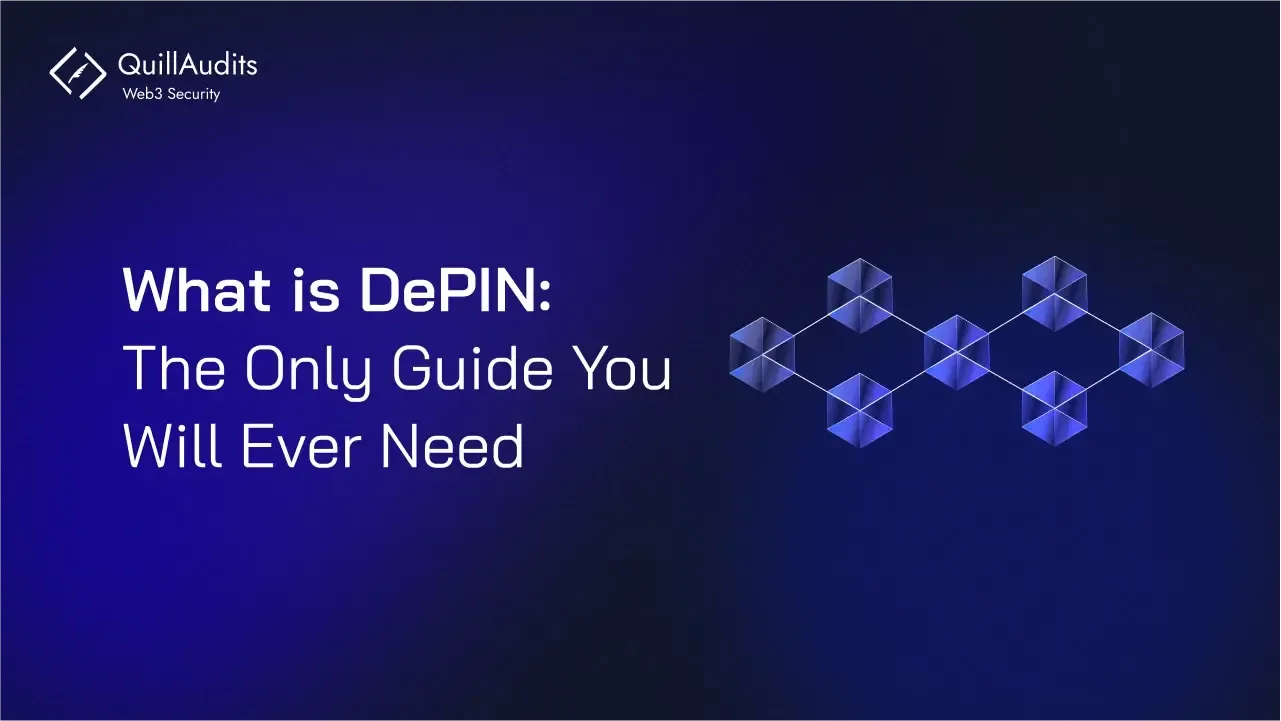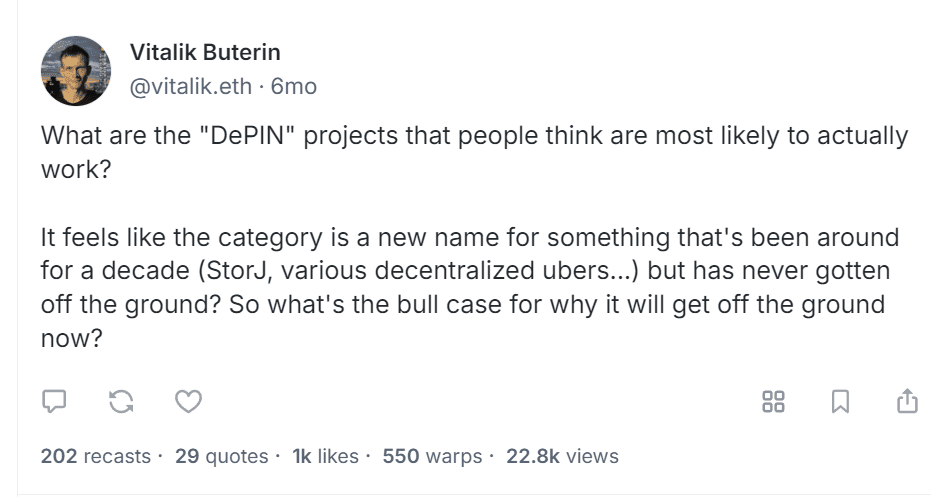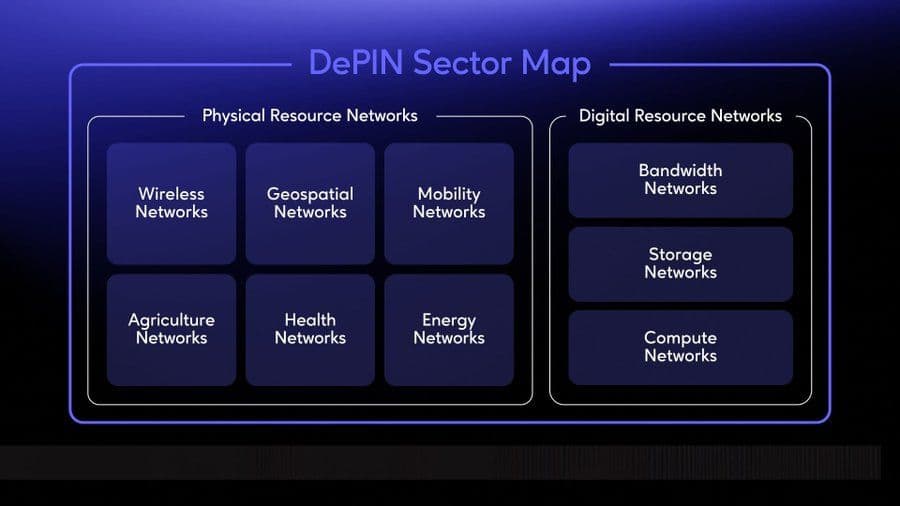What is DePIN? Exploring Decentralized Physical Infrastructure Networks
Explore our in-depth guide on DePIN to understand what it is, how it operates, and its essential features

Introduction
Ever heard of DePIN? No, it’s not the latest cryptocurrency meme. It stands for Decentralized Physical Infrastructure Networks, and it's poised to be a game-changer in how we think about infrastructure and blockchain technology.
Imagine a world where you contribute to a network with real-world assets like storage space, wireless connectivity, or even energy grids and get rewarded for it. That’s DePIN in a nutshell.
At its core, DePIN combines decentralized networks with physical infrastructure to create a fully decentralized and participatory system.
Picture this: instead of traditional infrastructure owned and managed by a central authority, everyday users can contribute tangible resources like storage space, internet bandwidth, environmental sensors, or even power from solar grids. In return, these users earn cryptocurrency as a reward for their contributions, establishing a new kind of economic model.
What is DePIN (Decentralised Physical Infrastructure Networks) in Crypto?
DePIN stands for Decentralized Physical Infrastructure Networks. It is a revolutionary concept that combines decentralized networks with real-world infrastructure. It allows users to contribute resources like storage, computing power, or energy to a decentralized network in exchange for tokenized rewards. As adoption grows, ensuring you're securing DePIN protocols becomes essential to mitigate vulnerabilities and maintain network integrity.
How DePIN Works?
DePIN operates on peer-to-peer (P2P) principles, meaning no middleman is necessary to manage the system. The blockchain verifies and coordinates the resources supplied by various participants.
Whether you’re offering unused storage from your personal devices, sharing a portion of your home Wi-Fi bandwidth, or setting up solar panels to feed energy back into the grid, DePIN allows for seamless participation.
Key Features of DePIN
- Decentralized Ownership: Traditional infrastructure models rely on centralized corporations controlling resources, while DePIN flips this on its head by letting anyone participate. You become part-owner of the infrastructure you're supporting.
- Tokenized Rewards: As participants supply resources to the network, they earn tokens in return. These tokens can represent ownership in the network, or simply be sold or staked for further rewards.
- Incentives for Participation: The token economy behind DePIN networks ensures that users are motivated to contribute. More contribution means more rewards, driving a self-sustaining ecosystem of supply and demand.
- Trustless Systems: Smart contracts ensure that no trust is required between users and the network. Blockchain’s immutability guarantees that resource-sharing agreements are automatically executed once conditions are met.
- Open Networks: New participants can join these decentralized networks without needing permission, significantly reducing entry barriers and making DePINs more accessible.
What’s Driving the Adoption of DePIN?
The booming interest in DePIN is fueled by several factors:
- Infrastructure Democratization: By decentralizing control, individuals gain the ability to own and manage parts of the physical infrastructure themselves, leading to wider adoption.
- Enhanced Security and Transparency: Blockchain technology ensures that resource allocation is transparent and tamper-proof.
- Economic Efficiency: The tokenized incentive structures encourage resource optimization, reducing the inefficiencies of centralized infrastructure systems.

Check Out Our Work
We've audited top DApps and DeFi protocols, ensuring they remain secure and Free from Hacks. Check out their audit reports to see our impact.

Vitalik Buterin’s Take on DePIN
Vitalik Buterin, the co-founder of Ethereum, has also weighed in on DePINs, emphasizing their potential to revolutionize physical infrastructure management. According to him, DePINs are more than just a tech trend; they represent a significant shift in how we build and maintain critical infrastructure.

PRNs vs. DRNs: The Two Faces of DePIN
DePINs (Decentralized Physical Infrastructure Networks) are a groundbreaking fusion of blockchain and real-world infrastructure, and they can be divided into two main categories: Physical Resource Networks (PRNs) and Digital Resource Networks (DRNs). Both serve essential roles in the DePIN ecosystem, but they address different needs and operate in distinct ways.
Physical Resource Networks (PRNs): The Grounded Powerhouses
Physical Resource Networks, or PRNs, represent the "boots on the ground" aspect of DePINs. These networks deal with location-dependent physical infrastructure—real-world, tangible resources that require a specific geographical presence.
How PRNs Work
PRNs operate by allowing participants to contribute their physical assets—whether that’s energy production, sensor data, or bandwidth—into the decentralized network. These participants can then earn rewards in the form of cryptocurrency or other digital tokens based on their contributions.
For example, someone with a solar panel array could connect their system to a DePIN, contributing excess electricity to the network and earning rewards for the energy generated. Similarly, someone could deploy wireless towers in rural areas and be compensated for providing network coverage.
The Importance of Location in PRNs
Location is a crucial factor in PRNs because these physical resources are inherently tied to where they are deployed. A wind turbine, for instance, can only generate electricity in a place where there’s wind. Similarly, geospatial sensors must be placed in specific locations to gather relevant data. The performance and value of a PRN are often determined by these location-based constraints, which means participants must carefully consider where to place their resources for optimal contribution to the network.
Applications of PRNs
- Decentralized Energy Grids: PRNs can create decentralized energy grids where individuals or small communities contribute renewable energy sources like solar panels or wind turbines to the network.
- Wireless Communication Networks: In the realm of telecommunications, PRNs allow individuals or businesses to deploy wireless infrastructure like 5G towers in under-served areas, contributing to a decentralized network and getting rewarded for the coverage they provide.
- Geospatial and IoT Sensors: PRNs can also involve networks of sensors that monitor environmental conditions, track assets, or provide other geospatial data. These networks can support smart cities or even climate monitoring systems, with contributors earning tokens based on the value of the data their sensors provide.
Digital Resource Networks (DRNs): The Cloud Warriors
On the other side of the DePIN coin, we have Digital Resource Networks (DRNs)—the "cloud warriors" of the decentralized infrastructure world. DRNs deal with resources that are not tied to a specific location and can be distributed globally. These networks are focused on digital assets like cloud storage, computational power (such as GPUs or CPUs), and bandwidth.
The key difference from PRNs is that DRNs are location-independent, meaning participants can contribute to the network from anywhere in the world.
How DRNs Work
In a DRN, participants contribute their digital resources—whether that’s cloud storage space, computing power, or internet bandwidth—to a decentralized network. These resources are then pooled together to create a distributed service that others can use. In exchange for providing these resources, contributors are rewarded with tokens or cryptocurrency.
For example, an individual with extra storage on their hard drive could contribute that space to a decentralized cloud storage network like Filecoin or Arweave, allowing others to store their data while earning rewards. Similarly, someone with a powerful GPU could offer their processing power to a decentralized compute network, contributing to tasks like rendering graphics, training AI models, or performing complex scientific calculations.
Location Independence in DRNs
Unlike PRNs, the key advantage of DRNs is their location independence. Digital resources like cloud storage or compute power don’t require any specific geographic placement to be useful. This makes DRNs highly scalable and flexible, as participants from anywhere in the world can contribute resources, and users from anywhere can access those resources.
Applications of DRNs
- Decentralized Cloud Storage: DRNs like Filecoin, Arweave, and Storj allow individuals to contribute unused hard drive space to a decentralized storage network. Users can then store their data in a more secure, censorship-resistant manner than traditional cloud storage services.
- Decentralized Compute Networks: Platforms like Golem and Render Network allow participants to contribute idle GPU or CPU power to a decentralized network, enabling tasks like rendering 3D models, processing large datasets, or even performing scientific research.
- Bandwidth Sharing: DRNs also include networks that allow participants to share their internet bandwidth with others. Projects like Mysterium and Helium enable people to contribute excess bandwidth to a decentralized VPN or wireless network, respectively, earning rewards for helping to provide internet connectivity to others.
The DePIN Flywheel: A Self-Sustaining Ecosystem
The DePIN flywheel is a virtuous cycle that powers the network’s growth. As more people use the network, demand for services increases, driving up token prices. This, in turn, attracts more contributors, expanding the network’s capacity and drawing in more investors. It’s a win-win situation for everyone involved.

Top DePIN Projects: Who’s Leading the Charge?
Some of the leading DePIN projects include:
- Filecoin (FIL): The largest DePIN project by market cap, offering decentralized cloud storage solutions.
- Render Network (RNDR): A distributed rendering platform that provides GPU power for high-end 3D content creation.
- Theta Network (THETA): A video delivery network that uses blockchain to create an efficient, decentralized streaming ecosystem.
Security in DePINs? Well, It’s Not All Sunshine & Rainbows
While DePINs offer transformative potential, they also introduce a unique set of security challenges. Since DePINs blend physical infrastructure with digital networks, the physical elements like hardware, are vulnerable to tampering, theft, or damage. Moreover, the decentralized nature of DePINs makes them susceptible to social engineering attacks, where malicious actors can exploit the trust between participants to manipulate the network.
To mitigate these vulnerabilities, it's crucial to incorporate strong encryption to protect data in transit and at rest, ensuring that even if a physical device is compromised, the data remains secure.
For a comprehensive approach to security, DePIN projects should regularly audit their smart contracts. Partnering with reputable security firms like QuillAudits for regular smart contract audits ensures that vulnerabilities are identified and fixed before they can be exploited.
Additionally, leveraging AI-driven auditing solutions like QuillShield offers another layer of security by providing continuous, automated auditing to detect and mitigate potential risks in real-time.
Secure Your Smart Contracts with QuillAudits
Ready to secure your smart contracts? Take the first step towards a safer blockchain journey. Request an Audit with QuillAudits today & ensure your contracts are robust and secure!
Final Thoughts
DePINs are more than just a buzzword; they represent a new way to plan, build, and operate physical infrastructure.
With the market cap of traditional infrastructure giants like Microsoft and Amazon towering at over $5 trillion, DePINs have a long way to go.
But with their scalable, efficient, and decentralized approach, the future looks bright. Whether it’s PRNs or DRNs, DePINs are poised to reshape how we think about and manage our world’s infrastructure.
Contents


